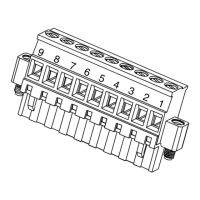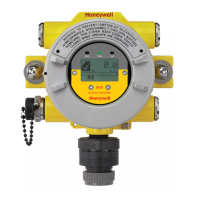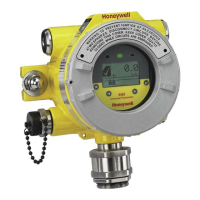XNX Universal Transmitter
Section 3 - Calibration
113
Note: Calibrate the sensor at the approximate alarm levels to allow for non-linearity of the sensors
at gas concentrations above 80% LEL.
EC Sensor Operational Life
The typical life of a toxic gas sensor depends on the application, frequency,
and amount of gas exposure. Under normal conditions (3 month visual
inspection and 6 month test/recalibration), the toxic sensor has an expected
life equal to or greater than these lifetimes:
• 12 months for ammonia, hydrogen chloride, and hydrogen uoride
sensors (see further ammonia information below).
• 18 months for uorine and ozone sensors.
• 24 months for chlorine dioxide, oxygen, and other toxic sensors.
See the Maintenance
section
for sensor replacement procedures.
Caution: Oxygen decient atmospheres (less than 6%V/V) may result in inaccurate readings and
substandard performance.
Ammonia electrochemical cells are reliable and suitable for applications
where no background concentration of ammonia exists. Under these
conditions the cells are expected to operate for 12 to 24 months. These
ammonia cells are of the consumptive type. Their operating life can be
adversely affected by continuous or excessive exposure to ammonia, or
by prolonged exposure to extremes of temperature and/or humidity.
To ensure continued detection availability, bump test the sensors
regularly and implement an appropriate cell replacement program.
Functional Gas Testing (Bump Testing)
Warning: Honeywell Analytics recommends bump testing of ClO
2
, Cl
2
, HF, HCl, HCN, F
2
and O
3
sensors frequently and in accordance with customer site procedures to ensure proper operation
and compliance with the functional safety rating of the installation.
Warning: Take appropriate precautions with cylinders of ammable or toxic gases. The calibration
procedure must be performed only by Honeywell-trained personnel.
Figure 215. Bump Test Menu
Warning: Exposure to desensitizing or contaminating substances or concentrations causing
operation of any alarm may affect sensor sensitivity. Following such events, verify sensor performance
by performing a bump test.
Test the sensor frequently to ensure that the system is operating
properly. Different sensor types may require more frequent
maintenance, depending on the environmental conditions and the
gases present. The weatherproof cover has a spigot for attaching
tubing from a gas cylinder. This may be used to bump test the sensor.
However, environmental conditions may make this unsuitable for some
gas types or applications. It is the responsibility of the user to ensure
suitability of this method for each application.
1. When bump test gas is applied to the sensor, the bump test
screen displays the current reading of the sensor and the peak
reading that occurred during the bump test.

